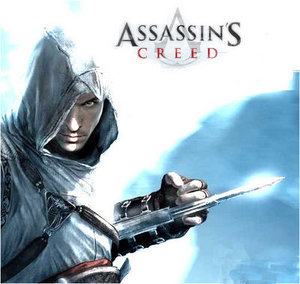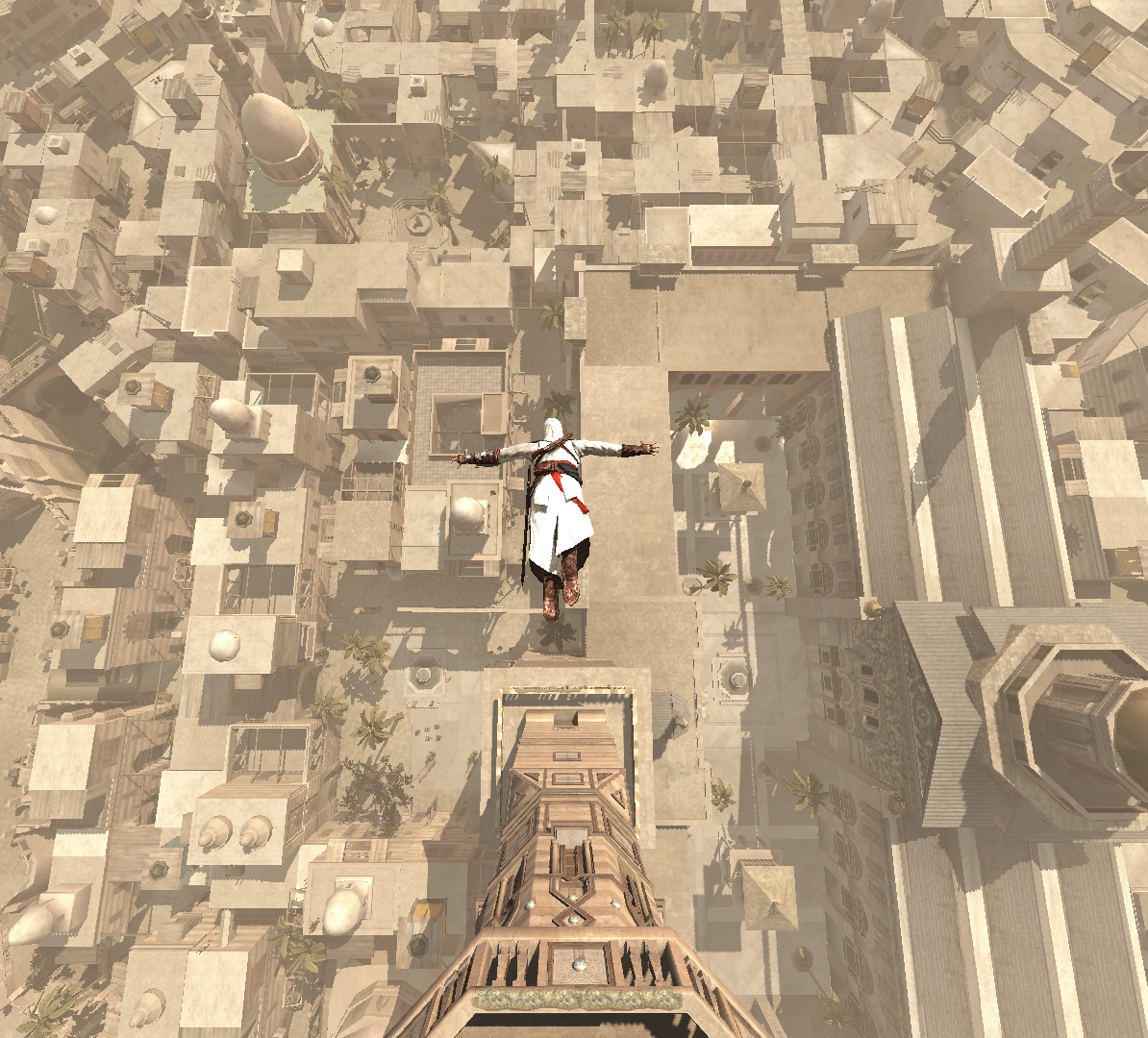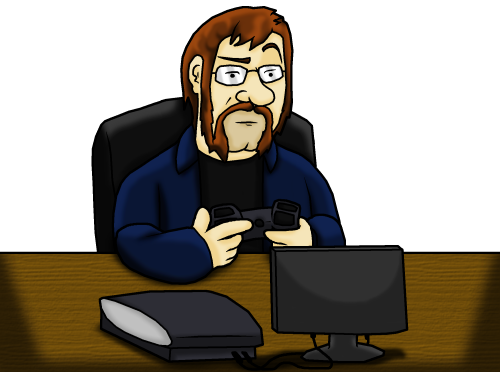Climbing on Historical Landmarks – an Assassin’s Creed Review
 This game always struck me as a very odd concept. It appears that the creative company behind the hit Prince of Persia trilogy (Ubisoft) sat down one day and decided to create a Grand Theft Auto clone with PoP’s sensibilities and the political soapbox cyberpunk intrigue of the Metal Gear Solid series. However, the twist comes in that in order to achieve the latter, they had to write an overly complex storyline in order to keep the “cyberpunk” aspect1.
This game always struck me as a very odd concept. It appears that the creative company behind the hit Prince of Persia trilogy (Ubisoft) sat down one day and decided to create a Grand Theft Auto clone with PoP’s sensibilities and the political soapbox cyberpunk intrigue of the Metal Gear Solid series. However, the twist comes in that in order to achieve the latter, they had to write an overly complex storyline in order to keep the “cyberpunk” aspect1.
Without going into too much detail and keeping all spoilers as far away from your eyes as possible, you play the role of Desmond. He is a bartender in the not-too-distant future (2012, to be precise) who has been kidnapped by a semi-futuristic Pharmaceutical company (think Aperture Science from Portal, only without the sense of humour) with the intentions of exploring his “DNA memory”. What the evil company basically want is to examine memories present in Desmond’s DNA that are passed down from his ancestors, but in order to do this he has to lie down on a machine called the “animus”, and actually live through the experiences of whatever ancestor he wants to see the memories of. Hold on, we’re almost there.
So with Desmond lying in the machine, you quickly learn of the game’s actual main character, Altair – he’s the awesome looking guy on the game’s front cover, who looks a little bit like the Prince from PoP and is probably part of the reason you actually bought the game. Altair, as we quickly learn, is an impetuous and arrogant character, and through a brilliant bit of introduction storyline and tutorial we follow him as he almost causes the destruction of his assassin clan, is stripped of his rank and forced to learn the basics of his trade over again, eventually being told that he must assassinate nine specific people before he can rejoin the clan at his original rank. So really you are playing a character playing a character (TIME PARADOX!).
If you played and dislike Metal Gear Solid 2 due to its convoluted story, this game will not entice you due to the story either. I must admit that even I felt at points that the only possible reason for the overly complicated plot was just an excuse to have a fancy menu screen and HUD (Head’s-Up Display). However, as you go through the game, the chunks of intermission “present-day” storytelling make for nice breaks to the action.
The actual gameplay is very much that of a GTA clone, except without the cars (obviously). Once freed from the seemingly never-ending series of tutorials you are unleashed upon an area of a city2 whereby you have a variety of options to choose from; you can scale tall buildings to survey the surrounding tasks available (collecting “view points”), save pedestrians (which in turn will provide groups of vigilantes and scholars that can help should you get into trouble), perform investigative tasks (pick-pocketing, interrogation and/or the pointlessly simple eavesdropping) or perform tasks for informants (collect flags within a time limit or silently assassinate a number of targets without discovery, with or without a time limit).
Unfortunately that is pretty much the full range of tasks available and it is only the investigative and informant tasks that really need to be carried out, and even then you rarely need to perform all of them in any particular city area before you are finally allowed to attempt to assassinate a target. Only the most patient players will gleam longevity from this game by completing all the tasks, which is quite a repetitive process, otherwise you could probably zip through this game in a day or two (but then you would be doing yourself a disservice).
The graphics and controls are fantastic, insofar that you can do a lot with any one button and it never gets confusing. Moves are separated into “low-profile” (pretending to be a monk, generally skulking) and “high-profile” (for when you really, absolutely have to kill everyone in the street). Low profile is standard, and the high profile moves are accessed by simply holding down the R1 button. Most of the time you will find yourself free-running across rooftops by holding down forward, R1 to sprint and X to actually react to gaps and walls (“clambering”, if you will). It is often quite easy to feel guilty when Altair performs marvellous looking acrobatics for such little input from the player.
The only complaints control-wise are sometimes Altair gets confused as to which ledge he should be grabbing on to (for example, one under a roof, or refusing to grab a ladder directly next to a ledge), which is problematic in situations where there is a whole squad of city guards after you. However, a lot of these moments are usually due to the player not being precise enough in controlling, and the tension of being slowed down actually adds to the excitement.
Combat is like a reactive game of chess. At first you are stuck with having to hack away at opponents, but once the counter attack, dodge and throw abilities are unlocked a whole new level of gameplay arises, especially later on in the game, where the guards are armoured and can throw, do counters to and guard-break you. Some battles feel like those fight scenes in old epic films made in the 1960s and set in ancient times. However, the combat can feel very bumbling at times, especially towards the end of the game where armoured opponents outnumber you greatly, and every other guard insists on guard-breaking you.
The actual assassinations came as a slight disappointment to me, too. Being a fan of Eidos’ Hitman series, I was expecting to have to assassinate the major targets as silently as possible. However, the situations where you face the nine major targets often do not allow for any tactic other than full-frontal assault. For example, one target is at a hanging ceremony, and at least one target springs a trap as you arrive through the only entrance to their building. Even if you manage to perform a silent kill on a target, after a cutscene the city alarm is raised and you are forced to escape the pursuing guards (think of it as “oh no, four stars!”).
Saying that, if you don’t mind the full-frontal assault kind of assassination (i.e. you blasted your way through at least one Hitman game in under an hour) then this game really is good, and could keep you entertained.
As I said before, the graphics are great. Each city (and even the vast “Kingdom” area between cities) is atmospheric and individual. I’d be tempted to say “authentic” too, but I’m no historian so I won’t go that far. The draw distance is astounding (you occasionally get a little bit of “pop-up” with people, but not with scenery), and on the tallest buildings you really do get a treat of a view.
I think that sums up the game pretty well. It is a treat to play and experience. It can be clumsy, confusing and annoying in places, but it is one of those games where you will be happy to take the bad with the good, and there’s a lot of good.
By the way, if you do get the game, there’s a cathedral in Jerusalem that is possibly one of the tallest structures I’ve ever scaled in any game, with a fantastic view to boot. Superb.

Post by Sean Patrick Payne+ | January 9, 2008 at 10:49 pm | Reviews, Video Games | No comment
Tags: Altair, Assassin's Creed, game review

